Hello all.
In 9 years I intend to leave it all behind and set sail for an indeterminate amount of time. The rough plan is to leave the TX Gulf Coast and slowly meander the world, including high latitudes.
Originally I was going to cash out my 401k at retirement and buy something pretty nice. I've since amended that plan and now will be buying a steel hull of some type and completing a top-to-bottom refit myself over the course of 9 years. I understand this is likely an insane proposition, but I'm very confident in my skills and like a lot of the pros - knowing every system front to back, financing the project over 9 years, complete customization, etc.
At a later date I would love to have my idea ripped apart to ensure there's nothing I'm not considering. But today, I'd like to hear your opinion oh how big is too big? Not during a crossing obviously because you can't be too big, but in your day-to-day cruising from port to port.
I'm looking at the 50-70' range; likely an older commercial fishing hull that draws 4-6'. However, some larger offshore supply vessels have caught my eye based on their blank-slate layout, but they're around 110'. I know the 110' will likely draft more, requiring me to anchor further out, but that extra length allows me to have a dinghy and a larger aluminum deep V that can get on plane and make quick runs to the dock.
I understand some smaller ports wont have a gantry capable of larger steel vessels, but other than your occasional bottom paint, have you ever had to been hauled out in an emergency type situation that needed to be handled immediately as opposed to a more equipped port?
Basically, what length and draft would you consider prohibitive for an average guy to bounce around the world?
To clarify some variables - assume a worst case of only 2 people on board, will be equipped with bow & stern thrusters, no intention on transient docking unless absolutely necessary (mooring/anchoring out always), a pretty healthy yearly cruising budget but nothing crazy, and no time-frame/schedule at all so weather windows will be chosen carefully.
Thanks all!

 , very heavy, single ... but at the first step when one of my broker friend contacted me it was a great opportunity, but later an another broker and a captain enter in the "equation" an no more interesting for us oups for me, because for my wife the size count and she don't want (too)big boat
, very heavy, single ... but at the first step when one of my broker friend contacted me it was a great opportunity, but later an another broker and a captain enter in the "equation" an no more interesting for us oups for me, because for my wife the size count and she don't want (too)big boat 